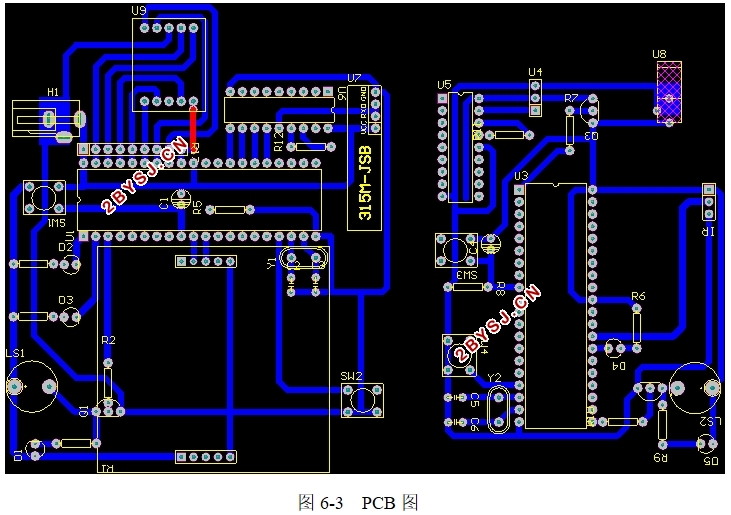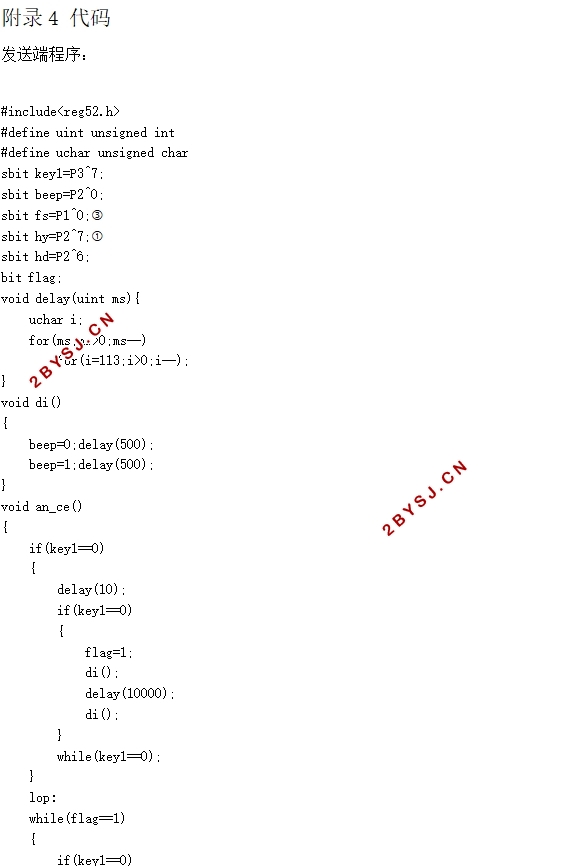红外无线报警系统的设计
无需注册登录,支付后按照提示操作即可获取该资料.
红外无线报警系统的设计(任务书,开题报告,论文16000字)
摘 要
本次设计是红外无线报警系统,实现了多种方式报警,有较高的可执行性,功耗低,安装方便。可以对用户的财产起到保护作用。
本文设计了一个发送端和一个接收端。发送端安装在用户家中,用红外传感器来探测红外信号,感知是否有人入侵,如果有人入侵,发送无线报警信号,响警铃;接收端安装在监控室,用来接收发送端发送来的无线报警信号,如有报警信号,就使用AT命令通过GSM模块发送短信给用户,同时响警铃。这样可以实现多地点、多方式的实时报警。发送端与接收端都采用单片机AT89C51来作为处理器芯片,分别运行各自的程序。
本次设计,完成了软硬件的设计、制作与电路联调。通过实验验证,系统运行功能正常,达到了规定的要求。
关键词:红外传感器 单片机 GSM模块 无线传输
Infrared Wireless Alarm System
Abstract
The infrared wireless alarm system is designed. It implements a variety of ways about alarm,. It has higher enforceability, low power consumption,and it is convenient to install. It can give the user the property protection.
In the design, I designed a sender and a receiver on working model . The sender is fixed in user’s home. The sender use infrared sensor to detect infrared signals and perceive anyone invasion. At the same time, it sends wireless alarm signal,and ring the alarm bells. The receiver is fixed in duty room.The receiver to receive the sender sends to wireless alarm signal. If there are any alarm signal, use AT commands through GSM module to send messages to users and ring the alarm bells.Such locations, multimode real-time alarm .The sender and the receiver by single chip microcomputer AT89C51 as the processor chip. The sender and the receiver respectively run their application, the sender through infrared sensors to high level to judge whether the alarm, the receiver by receiving wireless alarm signal to determine whether the alarm.
The design is completed the software and hardware design, make and circuit alignment. By experimental verification, the system normal operation function, has reached the requirement of regulations.
Key words: MCU; Infrared sensor; GSM module; wireless



目录
摘 要 I
ABSTRACT II
第一章 绪论 1
1.1 红外无线报警系统现状及发展趋势 1
1.1.1研究现状 1
1.1.2 发展趋势 1
1.2 红外无线报警系统的构成 2
第二章 系统的总体方案与设计 4
2.1系统的设计方案 4
2.2 主要器件的选择 5
2.2.1 红外线传感器的选择 5
2.2.2 处理器的选择 8
2.2.3 无线传输模块的选择 9
2.2.4 GSM模块的选择 11
2.3软件的设计思路 11
2.3.1 发送端软件设计思路 11
2.3.2 接收端软件设计思路 12
第三章 系统的硬件电路设计 13
3.1 红外探测电路的设计 13
3.2 单片机最小系统的设计 15
3.3 无线模块电路的设计 16
3.4 报警电路的设计 17
3.4.1 蜂鸣器电路的设计 17
3.4.2 GSM模块电路的设计 18
3.5 整体电路的设计的原理图 19
第四章 系统的软件部分设计 21
4.1 红外探测器的编程 21
4.2 无线传输模块的编程 22
4.2 串口程序编程 23
4.2.1控制GSM模块发送短信程序流程 23
4.2.2串口中断服务程序流程 26
4.3 系统的主程序设计 27
第五章 整体电路的联调 30
第六章 总结与展望 31
5.1 设计的结论与展望 31
5.2 自我总结 32
致谢 33
参考文献 34
附录1 原理与PCB图 36
附录2 实物图 38
附录3 器件清单 39
附录4 代码 40
